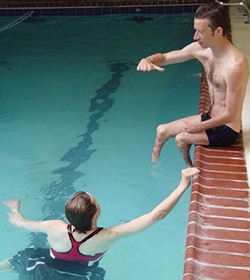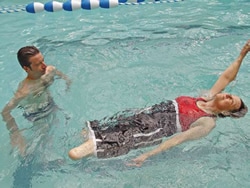Volume 18 · Issue 6 · September/October 2008 | Download PDF
by Elan Young
 For some amputees, getting in the water is the single most important part of their rehabilitation and recovery. A warm pool can offer soothing relief from aches and pains as well as an increased sense of balance. It can offer a chance to exercise freely without the burden of prosthetic limbs, and it can bring people together for meaningful social interaction. Those who have tried it swear by it, and physical therapists who use it in their programs have seen amazing results from a range of individuals with disabilities – especially amputees. Regaining the sense of movement can be a defining moment in the recovery process. When an amputee first slides into the water after an amputation during the recovery phase, he or she may experience water in wholly new and satisfying ways.
For some amputees, getting in the water is the single most important part of their rehabilitation and recovery. A warm pool can offer soothing relief from aches and pains as well as an increased sense of balance. It can offer a chance to exercise freely without the burden of prosthetic limbs, and it can bring people together for meaningful social interaction. Those who have tried it swear by it, and physical therapists who use it in their programs have seen amazing results from a range of individuals with disabilities – especially amputees. Regaining the sense of movement can be a defining moment in the recovery process. When an amputee first slides into the water after an amputation during the recovery phase, he or she may experience water in wholly new and satisfying ways.
Melissa Lewis, MPT, ATRIC, was the recent director of the aquatic therapy section of the physical therapy department at Walter Reed Army Medical Center, where she worked with many amputees. Her passion for aquatic therapy comes from its many known benefits, including the ones she discusses in her presentations about aquatic therapy for the amputee population, listed below.
Circulatory System. After the patient’s wounds have healed and before prosthetic rehab, amputees can still get intense cardiovascular workouts with aqua therapy.
Pulmonary System. The water’s hydrostatic pressure helps improve respiratory function without overtaxing the body. The water also allows the patient to become vertical without bearing weight on the residual limb, which is important to improving pulmonary function.
Musculoskeletal System. Increasing one’s strength before prosthetic training will help the amputee transition to weight-bearing activities on land. Early gait training activities can also be initiated in the pool before similar land-based activities. Individuals can obtain greater range of motion in knee and hip joints, which can stiffen from prolonged periods of time sitting in a wheelchair.
Central and Peripheral Nervous Systems. Warm water relaxes the body, allowing the patients to decrease focus on the stressors of everyday life. For amputees with significant pain, aquatic therapy is often more tolerable than land-based therapy. The warm water decreases pain perception, allowing amputees to perform more exercises in the water with less pain than the equivalent landbased exercises.
Mental Benefits. Being in the water leads to a change in mood. The amputee’s ability to move more freely in the water and participate in the same activities as other patients allows for a feeling of normalcy. The social aspect of being in the pool also improves mood.
After a while, the benefits of aquatic therapy overlap. By engaging in cardiovascular exercise, for example, weight loss becomes more easily achieved. Increasing one’s strength can lead to improvements in balance and gait. Water therapy might also lead to the enjoyment of adaptive water sports. Adaptive kayaking and scuba diving, for instance, can lead patients to experience new activities that they might not otherwise try, either with their families and friends or with others in the adaptive sports community. If used in association with therapy, it can allow the patient to recover more quickly and effectively.

Wening encourages amputees to take an active role in figuring out solutions to these problems so that they can still enjoy the benefits of aquatic activities. The First Swim™ participants he works with have taught him that water comfort is key to being able to enjoy recreational aquatics. “When a person is uncomfortable and nervous, their body tightens up, making it more difficult to float and adapt to the subtle movements of the water around them,” he says. His final advice is practical: “Relax, practice putting the face under water and breathing out the nose while holding onto the wall. If water accidentally gets in the mouth, just spit it out.”
Fortunately, many tools and techniques are available to amputees and aquatic therapists. Complete non-weight-bearing activities can be performed in deep water with the aid of flotation devices such as kickboards, and therapists can help individuals who don’t know how to swim by using flotation belts.
For the amputee who is comfortable going to a neighborhood pool, caution and safety is always advised. Slips and falls happen more easily when people hop on one leg, for instance. And even if you are comfortable in the water, always swim with a lifeguard present!
Related Resources
Aquatic Therapy and Rehab Institute
http://www.atri.org
International Council for Aquatic Therapy and Rehabilitation Industry Certification
http://www.icatric.org
Orthotic & Prosthetic Assistance Fund
http://www.opfund.org
USA Swimming
http://www.usaswimming.org


